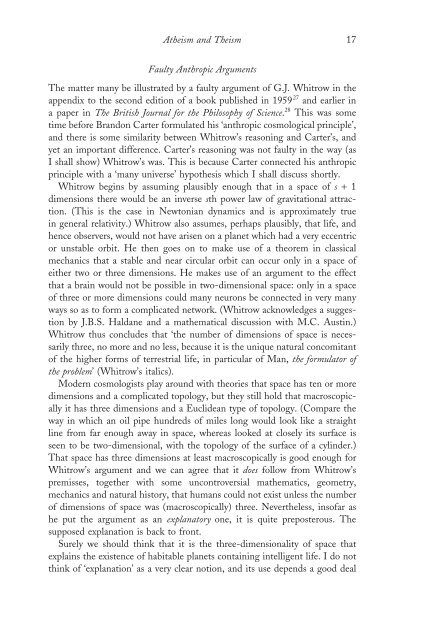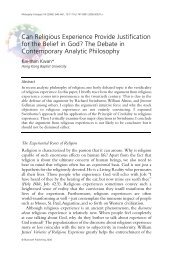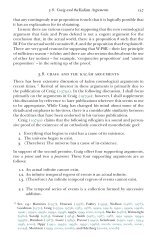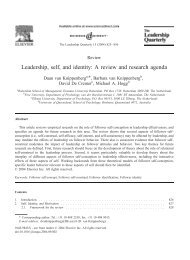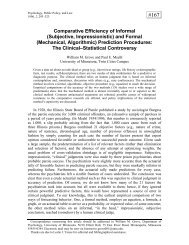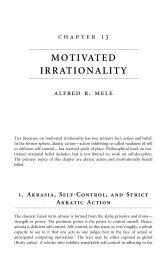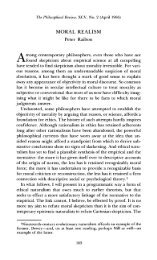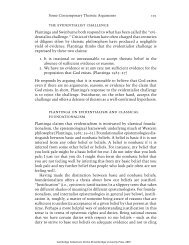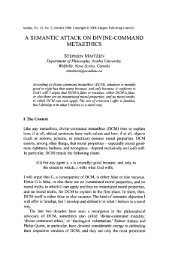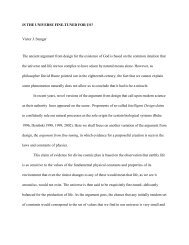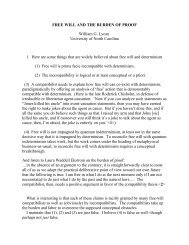Atheism and Theism JJ Haldane - Common Sense Atheism
Atheism and Theism JJ Haldane - Common Sense Atheism
Atheism and Theism JJ Haldane - Common Sense Atheism
Create successful ePaper yourself
Turn your PDF publications into a flip-book with our unique Google optimized e-Paper software.
<strong>Atheism</strong> <strong>and</strong> <strong>Theism</strong> 17<br />
Faulty Anthropic Arguments<br />
The matter many be illustrated by a faulty argument of G.J. Whitrow in the<br />
appendix to the second edition of a book published in 1959 27 <strong>and</strong> earlier in<br />
a paper in The British Journal for the Philosophy of Science. 28 This was some<br />
time before Br<strong>and</strong>on Carter formulated his ‘anthropic cosmological principle’,<br />
<strong>and</strong> there is some similarity between Whitrow’s reasoning <strong>and</strong> Carter’s, <strong>and</strong><br />
yet an important difference. Carter’s reasoning was not faulty in the way (as<br />
I shall show) Whitrow’s was. This is because Carter connected his anthropic<br />
principle with a ‘many universe’ hypothesis which I shall discuss shortly.<br />
Whitrow begins by assuming plausibly enough that in a space of s + 1<br />
dimensions there would be an inverse sth power law of gravitational attraction.<br />
(This is the case in Newtonian dynamics <strong>and</strong> is approximately true<br />
in general relativity.) Whitrow also assumes, perhaps plausibly, that life, <strong>and</strong><br />
hence observers, would not have arisen on a planet which had a very eccentric<br />
or unstable orbit. He then goes on to make use of a theorem in classical<br />
mechanics that a stable <strong>and</strong> near circular orbit can occur only in a space of<br />
either two or three dimensions. He makes use of an argument to the effect<br />
that a brain would not be possible in two-dimensional space: only in a space<br />
of three or more dimensions could many neurons be connected in very many<br />
ways so as to form a complicated network. (Whitrow acknowledges a suggestion<br />
by J.B.S. <strong>Haldane</strong> <strong>and</strong> a mathematical discussion with M.C. Austin.)<br />
Whitrow thus concludes that ‘the number of dimensions of space is necessarily<br />
three, no more <strong>and</strong> no less, because it is the unique natural concomitant<br />
of the higher forms of terrestrial life, in particular of Man, the formulator of<br />
the problem’ (Whitrow’s italics).<br />
Modern cosmologists play around with theories that space has ten or more<br />
dimensions <strong>and</strong> a complicated topology, but they still hold that macroscopically<br />
it has three dimensions <strong>and</strong> a Euclidean type of topology. (Compare the<br />
way in which an oil pipe hundreds of miles long would look like a straight<br />
line from far enough away in space, whereas looked at closely its surface is<br />
seen to be two-dimensional, with the topology of the surface of a cylinder.)<br />
That space has three dimensions at least macroscopically is good enough for<br />
Whitrow’s argument <strong>and</strong> we can agree that it does follow from Whitrow’s<br />
premisses, together with some uncontroversial mathematics, geometry,<br />
mechanics <strong>and</strong> natural history, that humans could not exist unless the number<br />
of dimensions of space was (macroscopically) three. Nevertheless, insofar as<br />
he put the argument as an explanatory one, it is quite preposterous. The<br />
supposed explanation is back to front.<br />
Surely we should think that it is the three-dimensionality of space that<br />
explains the existence of habitable planets containing intelligent life. I do not<br />
think of ‘explanation’ as a very clear notion, <strong>and</strong> its use depends a good deal


